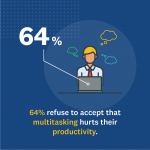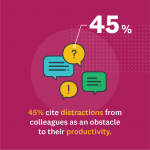However, ample research proves that we’re largely not productive. A study from Gallup found that only 33% of employees are engaged in their job, and while 64% of employees refuse to accept that multitasking hurts their work efficiency, its been proven to lower productivity by as much as 40%.

So when people believe that they’re being productive (when in fact they aren’t), they end up failing to accomplish the things they set out to do. What can employees do to improve their work rate?
To find out, we asked 485 employees on SurveyMonkey Audience about their productivity and the factors that raise—or lower—it. Here’s what we learned:
What are you curious about?
Use SurveyMonkey Audience to test ideas with your target market.
Focus on the right activities
People do all sorts of things in hopes of improving their productivity...without always getting the best results. For example, nearly a third of professionals eat snacks to be more productive (32%), but less than 3% are willing to say it helps their productivity the most.
Instead of defaulting to habit, focus on the behaviors that are proven to improve your work efficiency. Here are a few to help you get started:
- Make to-do lists. More than 20% of employees cite them as the leading contributor to their productivity—so they’ll probably be helpful for you, too. To-do lists ensure that tasks aren’t forgotten, and help you prioritize the right ones.
- Listen to music. Does classical music help you wind down? Will electronic music get you in the zone? Despite the fact that fewer than half of employees listen to music (45%), catching some tunes has been proven to lower your levels of anxiety and stress.
- Skip your late-night distractions and get more sleep. Being well-rested is a key part of being productive. How much is enough sleep? Most employees need at least 7 hours to feel productive the next day, but based on our previous research, more than half of people aren’t getting that much.
Spot distractions and then minimize their impact
Some distractions seem to be age-specific: Millennials are more likely than other generations to be distracted by social media, while older employees (45-60 years old) find workplace communications tools somewhat more distracting.
Others are more general. Here are three common distractions that affect people of all ages, and ideas for avoiding them:
- Chatty co-workers who keep you from working. Approximately 45% of employees claim to be distracted by their colleagues. This may not come as a surprise, since the rise of open-floor plans (adopted by roughly 70% of American organizations) has made interactions between co-workers easier.

While you may not want to be rude or come off as distant, you should still be able to work when you need to. Here are some ideas for overcoming your noisy neighbors:
- Find a quiet workspace in your office. There’s a reason why more than half of high-performing employees crave a little peace: It can help you focus and eventually get more done.
- Wear a pair of headphones. Not only do they block outside noise, but they also politely signal to co-workers that you’re busy.
- Treat side conversations as a mental breather. Taking frequent breaks improve your level of focus.
2. Meetings that don’t meet your needs. Nearly three-fourths (71%) of senior managers admit that meetings are often unproductive, while 65% even say that meetings get in the way of completing work.
Though meetings are an inevitable and often essential part of the workflow for employees, there are ways to limit their length and eliminate those that are less than necessary:
- Ask the organizer to add a meeting agenda in advance. This will help your team stay focused during the allotted time. Clear agendas can also help coworkers know whether they can choose to skip the meeting.
- Assign a timekeeper for every meeting. This person is responsible for ensuring that a meeting starts—and ends—on time.
- Use a simple meeting survey. Send this out after longer meetings and/or those that are recurring. The feedback can help the organizer find ways to shorten it for the next time.
Need help asking the right post-meeting survey questions? Get some ideas from our template.
3. Unclear work expectations. Only about half of employees know what’s expected of them at work.
While your manager might be largely responsible for this problem, you can also take action to help clear up any uncertainty:
- During 1:1 meetings with your manager, ask questions like, “How does my work fulfill the company’s goals?” and, “How can I improve the partnership with my team?” These can help you prioritize tasks and improve your collaboration.
- Propose an approach to a specific assignment, and then ask your manager what he or she thinks of your direction. You should be able to get more specific guidance.
- If direct contact with your manager is uncomfortable, you can offer candid and anonymous feedback on an employee survey. Talk to your HR department about using surveys to improve employee expectations and performance.
With so many different stimuli, it’s a tough time to be productive. The good news is that you have control over these distractions. It’s just a matter of being aware of them and then taking the right steps to limit their impact.
Now that you have more tools to help you focus, go get stuff done!
Create your own stories based on data
Our content marketing guide will teach you everything you need to know about creating content based on original research from survey data.



